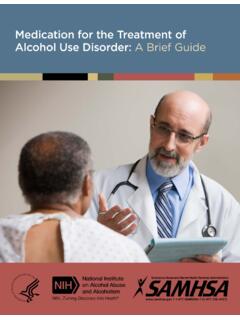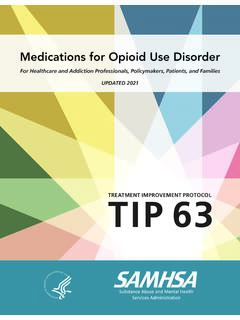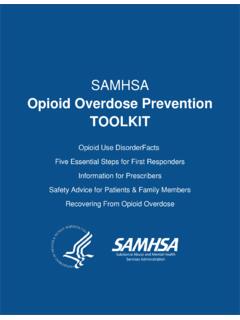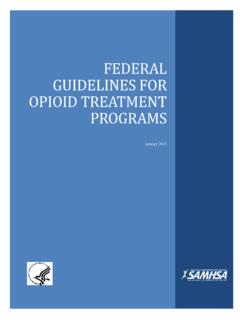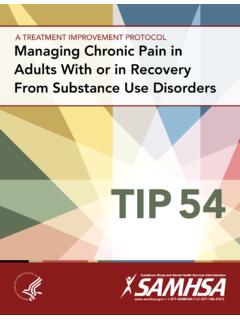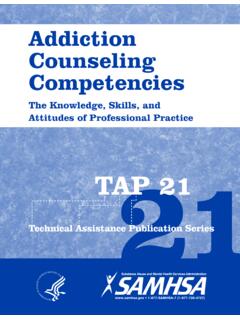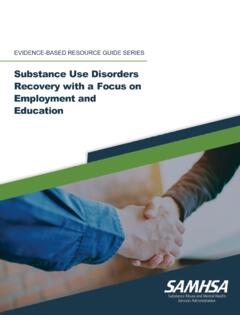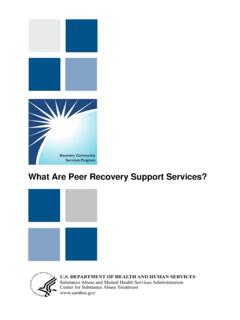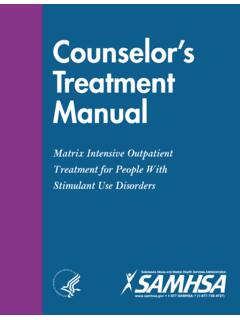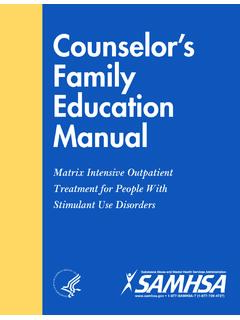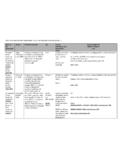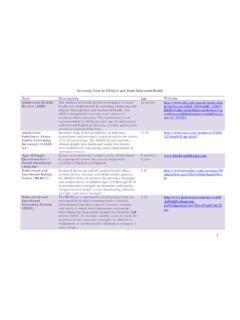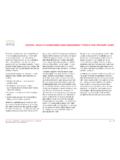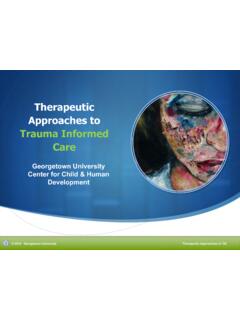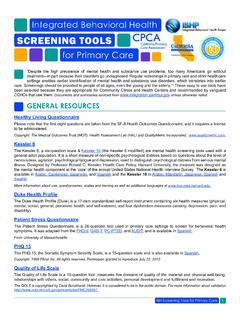Transcription of Screening and Treatment of Substance Use Disorders among ...
1 Screening AND Treatment OF Substance . USE Disorders among ADOLESCENTS. Adolescence is a stage of rapid physical, emotional, and social development. Adolescents develop a stronger sense of self, have a greater need for independence, and form important relationships with peers and people other than their parents (Silvers et al., 2019). Signs of adolescent Substance Use During this stage, adolescents increasingly engage in risk-taking behaviors, including Trouble sleeping or oversleeping Substance use. Negative relationships with Changes in overall energy levels family and an unsafe home environment, Difficulty in daily functioning in particular, can increase risk-taking and Loss of interest in hobbies and friends Substance use in adolescents (Otten et Changes in appetite and weight al.)
2 , 2019). Because of these concurrent Extreme mood changes complexities, Treatment for Substance Becoming withdrawn use disorder (SUD) in adolescents needs Resisting authority to be responsive to their developmental Becoming disruptive or aggressive at differences, and distinct from Treatment for home or in the classroom adults. This Advisory summarizes key messages and considerations for Screening and treating adolescents with SUDs. It is based on the Substance Abuse and Mental Health Services Administration's (SAMHSA) Treatment Improvement Protocol (TIP) 31, Screening and Assessing Adolescents for Substance Use Disorders and TIP 32, Treatment of Adolescents with Substance Use Disorders .
3 According to the 2019 National Survey on Drug Use and Health, percent of all adolescents aged 12 to 17 used illicit drugs in the past year. An estimated percent of adolescents had a past year SUD. The percentage of adolescents who used alcohol in the past month was percent, while the percentage who used cigarettes was percent. Marijuana use in the past year for this group was percent. Rates of Substance use and SUD have remained stable since 2015 (SAMHSA, 2020a). Adolescents with untreated or undertreated SUDs are at risk for experiencing adverse outcomes into adulthood, including criminal involvement (Racz et al.)
4 , 2016), sexually transmitted infections (Dembo et al., 2009), unintended pregnancy (Chapman & Wu, 2013), and co-occurring mental Disorders (National Institute on Drug Abuse, 2020a). adolescent Substance use is associated with violence and unintentional injury two of the leading causes of death for this population (The National Center on Addiction and Substance Abuse, 2011). 1. ADVISORY. Given the rates of Substance use and the negative impact it can have on adolescents, interventions are needed to prevent it, intervene when use or misuse occurs, and facilitate recovery.
5 This Advisory provides an overview of the Screening , Brief Intervention, and Referral to Treatment (SBIRT) approach, an integrated and comprehensive early intervention implemented in primary care and other settings to identify, reduce, and prevent Substance use (Abt Associates, 2020; Del Boca et al., 2017; National Council for Behavioral Health, 2019; see The SBIRT Process' below). Key Messages Adolescents are developmentally distinct from adults and require different approaches for SBIRT. SBIRT can occur in a variety of settings, including: o Primary Care The American Academy of Pediatrics (AAP) and SAMHSA recommend universal Screening within primary care for adolescent Substance use.
6 Many adolescents see their primary care physician (PCP) annually. During visits, PCPs routinely screen adolescents for diseases and promote wellness. Therefore, they are uniquely positioned to screen for Substance use and provide brief intervention before serious problems occur. Teens also perceive PCPs as knowledgeable and informative and are likely to listen to their guidance. If warranted, PCPs can also engage in a brief intervention using motivational interviewing aimed at reducing drug and alcohol use. o Schools and Other Community Organizations ( , religious organizations, sports teams, social clubs, criminal justice agencies, youth centers).
7 Screening and brief interventions can also occur in settings that are important in an adolescent 's life. Staff and volunteers in schools and community settings should receive training that enables them to identify concerns with adolescent Substance use. In these settings, staff can provide prevention education and screen and refer youth to additional services, as needed. Screening should be brief, relevant for adolescents, and culturally appropriate. Additional assessment determines whether an adolescent needs Treatment and identifies factors contributing or related to SUD.
8 Brief interventions for Substance use can include a brief conversation using motivational interviewing to reduce use and risk behavior. SUD Treatment for adolescents needs to be tailored to each individual's development and include potential contributors to their behavior ( , childhood trauma and family concerns). Adults who interact with youth should be aware of Substance use and SUD warning signs, as well as appropriate services in the community for referrals and additional support. Confidentiality is important. Healthcare providers, teachers, and others should avoid breaking trust with adolescents, while balancing the need to ensure their safety.
9 2. SAMHSA'S mission is to reduce the impact of Substance abuse and mental illness on America's communities. 1-877-SAMHSA-7 | (1-877-726-4727) 1-800-487-4889 (TDD) ADVISORY. Classification of a Substance Use Disorder In 2013, the diagnostic criteria for classifying a SUD changed. The Diagnostic and Statistical Manual of Mental Disorders , 5th Edition (DSM-5) provides criteria for determining the severity of a SUD. If an individual meets none or one of the criteria, he or she is categorized as having No Disorder. Meeting two to three criteria classifies a person as having a Mild Disorder.
10 Four to five criteria are categorized as Moderate Disorder, and if a person meets six or more criteria, they are categorized as having a Severe Disorder (SAMHSA, 2016). The flowchart in Exhibit 1 shows how Screening can lead to anticipatory guidance ( , the healthcare provider anticipates emerging issues that an adolescent and family may face), brief intervention, or Treatment ( , therapy, medication-assisted). Screening & Assessing Adolescents for Substance Use and Substance Use Disorder Screening in a Medical Office Although the Preventive Services Task While most adolescents' medical visits are Force and American Academy of Family for acute care, one third of adolescents Physicians found insufficient evidence to have a preventive care visit each year assess the benefits and harms of PCP-based (Rand & Goldstein, 2018).
